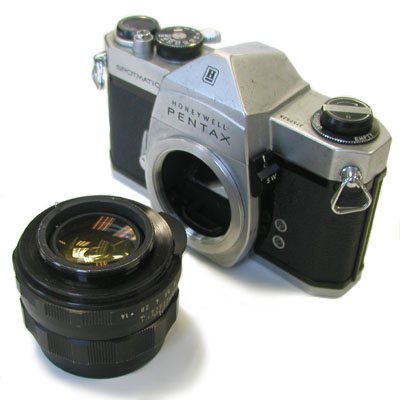Thoriated Camera Lens (ca. 1970s)

In designing optical lenses, it is often desirable to employ glass with a high index of refraction. The greater the index of refraction, the greater the bending of the light. Since this reduces the necessary curvature of the glass, the lens can be made thinner and lighter. Unfortunately, glass with a high refractive index can also have a high dispersion. By adding thorium to the glass, a high refractive index (over 1.6) can be achieved while maintaining a low dispersion.
A couple of patents for optical glass containing thorium were issued in 1939 that were of a somewhat general nature. Later, in 1949, a patent with a couple of specific formulations for such glass was issued to Paul De Paolis at Kodak. One formula, by weight, was:
- Boron 36%
- Lanthanum 12%
- Thorium 12%
- Barium 20%
- Calcium 20%
Later formulations included up to 28% thorium oxide.
Based on the dates of the previously mentioned patents, I suspect that the first commercial lenses to incorporate thorium appeared in the 1950s. These lenses have been employed in a variety of applications including television cameras, 35 mm cameras, military optics, microfilm readers and aerial cameras. The production of such lenses seems to have ended in the late 1980s.
Camera lenses known to have contained thorium include:
- Canon FL 58mm f1.2
- GAF Anscomatic 38mm f2.8 (Anscomatic 726 camera)
- Kodak Ektanar 38mm f2.8 (Instamatic 804 camera)
- Kodak Ektanon 46mm f3.5 (Signet 40 camera)
- Kodak Ektanon 50mm f3.9 (Kodak Bantam RF camera)
- SMC Takumar 50mm f1.4 (Asahi Optical Co.)
- Super Takumar 35mm f2.0, 50mm f1.5, 55mm f2 (Asahi Optical Co.)
- Super Takumar 6x7 105mm f2.4 (Asahi Optical Co.)
- Super-multi-coated Macro-Takumar (Asahi Optical Co.)
- Yasinon-DS 50mm f1.7 (Yashica)
The gamma and beta emissions from high thorium content lenses in photographic cameras have the potential to degrade the film if the latter was left in the camera for a substantial period of time. In addition, the self-irradiation of the camera lens leads to a gradual darkening of the glass that reduces light transmission. As a result, it is not unusual to see a reddish brown color to the glass of older lenses.
Dose Estimates
Perhaps the greatest health concern is the potential for thoriated glass to be used in an eyepiece. This is not permitted by the regulations, but it has occurred. If the eye is positioned close to a thoriated eyepiece, the dose to the eye’s outer tissues can be substantial. Casarett et al, assuming that an individual used an eyepiece containing 16% thorium for 20 hours per week, estimated a dose of 44 rad at a depth of 50 um, and 18 rad at a depth of 60 um. Given a quality factor of 20, this would equate to 880 rem and 360 rem per year respectively. Similar calculations by McMillan and Horne were in general agreement with these numbers. One measurement, as opposed to a theoretical calculation, indicated a dose rate of approximately 1 mrad/hr at the surface of an eyepiece containing 18% thorium.
NUREG-1717 estimated that the dose to the operator of a television camera using thoriated lenses could be as much as 60 mrem per year. This assumed that three of the camera’s lenses contained 30% by weight thorium and that the camera man was positioned behind the camera for 1000 hours per year. Nevertheless, there is no evidence to suggest that thoriated lenses are commonly used in television cameras.
Measurements have indicated that the exposure rate at a depth of 10 cm in the body of an individual carrying a camera containing 0.36 uCi of thorium would be approximately 0.01 mrem/hr. Based on this value, NUREG-1717 calculated that a serious photographer might receive an annual exposure of 2 mrem. This assumed that the photographer carried the camera 30 days per year and for 6 hours per day. They also estimated an exposure of 0.7 mrem per year for an average photographer. If the camera lens contained the maximum permitted concentration of thorium (30%), NUREG-1717 estimated that the aforementioned annual doses could triple.
Pertinent Regulations
10 CFR 40.13 Unimportant quantities of source material (2003)
(c) Any person is exempt from the regulation in this part and from the requirements for a license set forth in section 62 of the Act to the extent that such person receives, possesses, uses, or transfers:...
(7) Thorium contained in finished optical lenses, provided that each lens does not contain more than 30 percent by weight of thorium; and that the exemption contained in this subparagraph shall not be deemed to authorize either: (i) The shaping, grinding or polishing of such lens or manufacturing processes other than the assembly of such lens into optical systems and devices without any alteration of the lens; or (ii) The receipt, possession, use, transfer, or of thorium contained in contact lenses, or in spectacles, or in eyepieces in binoculars or other optical instruments.
References
- Radiation Exposure of the U.S. Population from Consumer Products and Miscellaneous Sources. NCRP Report No. 95; 1987.
- Nuclear Regulatory Commission. Systematic Radiological Assessment of Exemptions for Source and Byproduct Materials. NUREG 1717. June 2001.
- Eberlin, W.W., and Paolis, P.F. Optical Glass. U.S. Patent 2,241,249. May 6, 1941.
- Morey, G. Optical Glass. U.S. Patent Reissue Re. 21,175. August 15, 1939.
- Paolis, P.F. Optical Glass. U.S. Patent 2,466,392. April 5, 1949.
